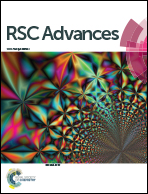Electrospun carbon nitride supported on poly(vinyl) alcohol as an electrocatalyst for oxygen reduction reactions
Abstract
Electrochemical oxygen reduction reactions (ORRs) via nonprecious catalysts have potential for significant cost reduction in fuel cells. Dense, multi-layered poly(vinyl) alcohol (PVA) nanofibers dispersed with catalytically active carbon nitride (CNx) nanoparticles were synthesized using an electrospinning process. The size, morphology, elemental composition, and bond structure of the CNx/PVA nanofibers were analysed using TEM, SEM, FTIR, XPS and Raman spectroscopic studies. Significant improvement in the electrocatalytic activity of the CNx nanoparticles dispersed in the nanofibers as compared to their native form was observed towards the ORR using voltammetry coupled with FTIR studies. The onset potential and peak current density observed for the CNx/PVA nanofibers using cyclic voltammetry were comparable to those of a conventional Pt/C (40 : 60% by weight) catalyst. The ORR mechanism was further analysed using a RRDE and in situ FTIR with linear sweep voltammetry studies. RRDE analysis confirmed that the ORR takes place primarily via a 4-electron pathway. The catalytic activity of the CNx/PVA nanofibers for the ORR was stable over 5000 repetitions in the voltammetric studies coupled with FTIR.


 Please wait while we load your content...
Please wait while we load your content...